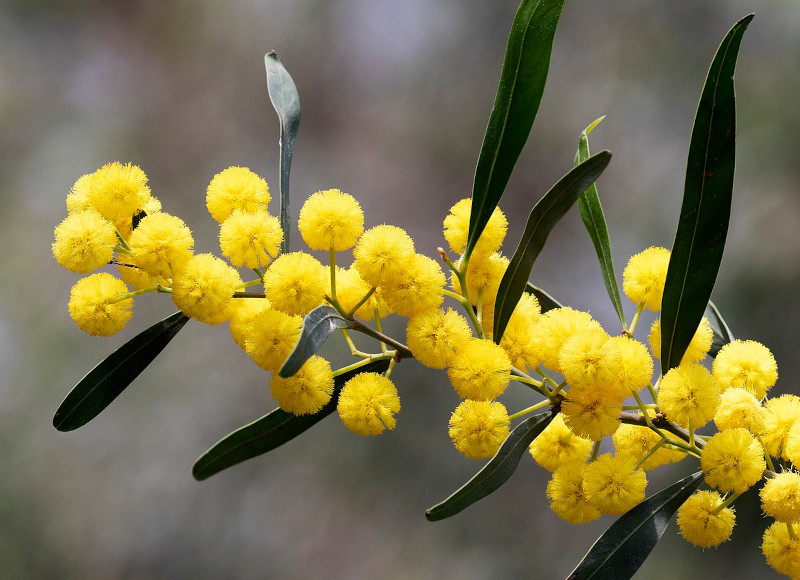
Orange Wattle Facts
- The most often employed name for this enchanting product of Nature and evolution remains the simple term of Orange Wattle. Yet, the remarkable plant also has a number of other terms by which it’s known. Blue-leafed wattle and coojung form a few.
- Inside the scientific community, however, this marvel of creation likely more frequently goes by its technical title. Thankfully, that’s a very simple one for the layperson to pronounce, as such things go. That’s because it holds the formal tag Acacia saligna.
- This stunning Angiosperm received that short moniker due to the efforts of Heinrich Ludolph Wendland. The respected German botanist accomplished the first recognition of it as a separate and distinct species. He managed that notable feat in 1792.
- The plant merits attention for several reasons. Sadly, not all of them qualify as good, however. It’s become highly invasive in some parts of the world where introduced. It’s also worth noting that, despite its appearance, it’s actually a member of the pea Family!
- Fortunately, for those who enjoy the flora, the Orange Wattle appears to have a stable population. That state further seems to hold true across its entire native range. The IUCN therefore currently lists the amazing Eudicots as Least Concern on its Red List.
- The amazing natural wonder nonetheless faces several potential threats to its continuation as a species. Like most life on earth, many of these stem from the actions of humans. These include the related perils of habitat loss and ongoing climate change.
Related Articles
Orange Wattle Physical Description
The eye-catching Orange Wattle typically does precisely that among those individuals fortunate enough to encounter one. Unlike many related species, however, it does so for more than just how it looks. That’s true since it also attains very respectable dimensions.
Fully mature examples sometimes attain heights meauring up to approximately 26.2 ft (8 m). Most trees remain somewhat shorter than that, though. It’s additionally known for its extremely dense nature, which often makes it more closely resemble a bush or shrub.
The flora develops a single, thick trunk. Its bark evolved as smooth in texture. That of most younger specimens exhibits a light gray on the main body. The smaller branches, though, usually present a reddish-brown shade. These darken to gray and fissure with age.
Those same branches also develop in prodigious numbers, and have a strong tendency to droop under their own weight. Impressively, many specimens achieve a girth greater than their height, due to the sheer number of limbs produced, and the quantity of leaves, as well.
The foliage of the Orange Wattle develop as thin and highly elongated, coming to a sharp point. Each varies significantly in length, even on the same tree. Average length ranges from 3.1 – 9.8 in (8 – 25 cm). These also typically display a moderate to dark green hue.
Yet, it’s the flowers of the incredible tree that gain the most notice. These appear in large clusters, numbering from 25 – 78. Each is rounded, and a dazzling yellow in color. Though tiny, ranging from only 0.2 – 0.4 in (0.5 – 1 cm), the clusters grow in vast numbers.
- Kingdom: Plantae
- Phylum: Tracheophyta
- Class: Magnoliopsida
- Order: Fabales
- Family: Fabaceae
- Genus: Acacia
- Species: A. saligna
Orange Wattle Distribution, Habitat, and Ecology
The highly distinctive Orange Wattle evolved as endemic to a relatively minor expanse of the surface of the eath. Given its unusual nature, the precise location of that zone of habitation likely will come as nor surprise. That’s true since it developed as native Australia.
Yet, even there this amazing product of natural evolution only resides natively in a minor portion of the continent. More precisely, it just occurs naturally in the southwestern section of the country. It’s now been spread other areas of the country, and the world, though.
Inside of that native habitat zone, the species displays a remarkable degree of versatility regarding where it appears. Due to this ability, the Angiosperm frequently develops in a wide variety of ecosystems. This also accounts for its invasive behavior outside its own range.
On its own, and in its endemic area, it primarily appears in conditions where many other flora perish. These include such regions as swampy areas, sand, coastal plains, river banks, and even smaller, rocky hillsides. It also flourishes where the soil’s been disturbed.
The blooms of the magnificent Orange Wattle manifest in late winter or early springs. Following their appearance, the species accomplishes its pollination via the activities of various local insects. These include numerous types of wasps, bees, and beetles.
Once produced, seeds fall to the ground, and more insect action occurs. Ants take them to their nests, but disturbance of the soil brings some to the surface. Once there, these germinate easily, with sometimes hundreds of seedlings appearing under a parent tree.
Species Sharing Its Range
Western Underground Orchid
Check out our other articles on Eastern Gray Squirrel, Indian Vulture, Cheddar Gorge, Great Barracuda, Mountain Apollo, Southern Darwin’s Frog, Snake Plant, Alligator Snapping Turtle
